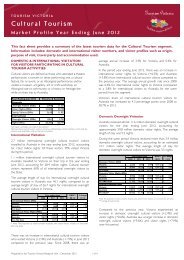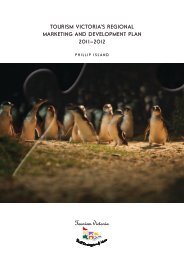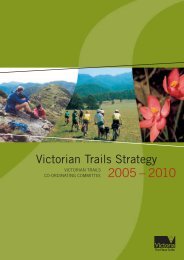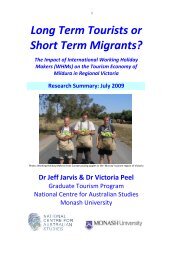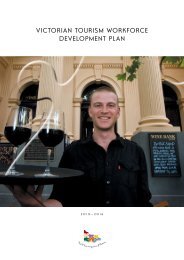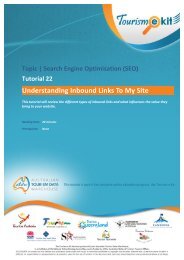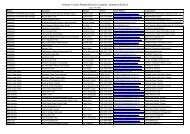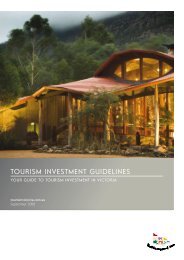The economic impact of the 2011 Formula 1 ... - Tourism Victoria
The economic impact of the 2011 Formula 1 ... - Tourism Victoria
The economic impact of the 2011 Formula 1 ... - Tourism Victoria
You also want an ePaper? Increase the reach of your titles
YUMPU automatically turns print PDFs into web optimized ePapers that Google loves.
10% confidence interval 1 . For <strong>the</strong> Assessment, representative samples regarding length <strong>of</strong><br />
stay and expenditure data were achieved for approximately 83% <strong>of</strong> direct expenditure<br />
associated with <strong>the</strong> behaviour <strong>of</strong> retained <strong>Victoria</strong>n spectators and organisations, and<br />
specific and extended stay interstate and overseas spectators and organisations. Ernst &<br />
Young’s processes identified that <strong>the</strong> non representative data applied to <strong>the</strong> remaining 17%<br />
<strong>of</strong> <strong>the</strong> estimate <strong>of</strong> <strong>the</strong> direct expenditure <strong>of</strong> <strong>the</strong> Grand Prix was not considered to be<br />
unreasonable.<br />
Economic <strong>impact</strong> <strong>of</strong> <strong>the</strong> Grand Prix<br />
Ernst & Young commissioned <strong>the</strong> Centre <strong>of</strong> Policy Studies (at Monash University) to model <strong>the</strong><br />
<strong>economic</strong> <strong>impact</strong> <strong>of</strong> <strong>the</strong> Grand Prix. <strong>The</strong> Computable General Equilibrium (‘CGE’) modelling<br />
approach used was a comparative static analysis. That is, comparing <strong>the</strong> state <strong>of</strong> <strong>the</strong> economy<br />
with <strong>the</strong> Grand Prix, and <strong>the</strong> state <strong>of</strong> <strong>the</strong> economy without <strong>the</strong> Grand Prix in <strong>2011</strong> (all else<br />
remaining constant), and <strong>the</strong>n estimating <strong>the</strong> changes in <strong>economic</strong> aggregates.<br />
<strong>The</strong> licence fee paid by <strong>the</strong> AGPC to <strong>the</strong> overseas owner <strong>of</strong> <strong>the</strong> Grand Prix is an important<br />
consideration in <strong>the</strong> <strong>economic</strong> evaluation. <strong>The</strong> data provided by <strong>the</strong> AGPC has not<br />
separately identified <strong>the</strong> licence fee due to confidentiality reasons. Instead, it is included as<br />
part <strong>of</strong> expenditure by <strong>the</strong> AGPC on overseas ‘personal and o<strong>the</strong>r services’. Treating <strong>the</strong><br />
industry grouping expenditure as income transfer results in <strong>the</strong> most conservative<br />
modelling outcomes. As this <strong>economic</strong> assessment takes a conservative approach, this<br />
assumption was adopted. However, it is likely that <strong>the</strong> estimated results <strong>of</strong> <strong>the</strong> staging <strong>of</strong> <strong>the</strong><br />
Grand Prix are lower than <strong>the</strong>y would be if <strong>the</strong> licence fee to stage <strong>the</strong> Grand Prix was<br />
known.<br />
Table 2 presents <strong>the</strong> macro<strong>economic</strong> results <strong>of</strong> <strong>the</strong> two Grand Prix scenarios, namely <strong>the</strong><br />
change in Gross State Product (‘GSP’), real investment and private consumption in <strong>Victoria</strong>,<br />
and additional full time equivalent employment created.<br />
Table 2 Macro<strong>economic</strong> variables (absolute deviations from baseline values): <strong>Victoria</strong><br />
Scenario 1: Relative to <strong>the</strong><br />
Grand Prix not held in<br />
<strong>Victoria</strong> but held interstate<br />
Scenario 2: Relative to <strong>the</strong><br />
Grand Prix not held in<br />
<strong>Victoria</strong> but held overseas<br />
Real GSP $39.34m $32.04m<br />
Real private consumption -$14.93m -$18.02m<br />
Real investment $9.67m $6.64m<br />
Employment (FTE jobs) 411 351<br />
Source: Economic Impact <strong>of</strong> <strong>the</strong> <strong>2011</strong> Australia <strong>Formula</strong> 1 Grand Prix: Tables <strong>of</strong> Final Results from MMRF, Centre <strong>of</strong><br />
Policy Studies, Monash University.<br />
<strong>The</strong> real GSP reflects <strong>the</strong> market value <strong>of</strong> all final goods and services produced in <strong>the</strong><br />
<strong>Victoria</strong>n economy over <strong>the</strong> modelling period, after deducting <strong>the</strong> cost <strong>of</strong> goods and<br />
services used up in <strong>the</strong> process <strong>of</strong> production. <strong>The</strong> results <strong>of</strong> Scenario 2 are more modest<br />
than those <strong>of</strong> Scenario 1 because <strong>Victoria</strong>ns are less likely to travel overseas to attend <strong>the</strong><br />
event and as a result, less money leaves <strong>Victoria</strong>.<br />
<strong>The</strong> real private consumption, reflecting household expenditures on goods and services, is<br />
in effect, negative. This is largely caused by <strong>the</strong> <strong>economic</strong> modelling assumption that<br />
certain international expenditure <strong>of</strong> <strong>the</strong> AGPC is treated as an income transfer ra<strong>the</strong>r than<br />
an import. <strong>The</strong> leakage <strong>of</strong> domestic income, all else constant, will result in a reduction in<br />
consumption.<br />
<strong>The</strong> real investment reflects expenditure on capital formation, while <strong>the</strong> employment is <strong>the</strong><br />
full time positions generated by <strong>the</strong> <strong>economic</strong> activity.<br />
1<br />
Partnerships <strong>Victoria</strong>, Public Sector Comparative: Appendix E: Statistical probability techniques and sample<br />
distributions – “It is not possible to obtain an estimate <strong>of</strong> probability that is 100% correct. An appropriate trade-<strong>of</strong>f<br />
between ma<strong>the</strong>matical accuracy and meaningful estimate <strong>the</strong>refore needs to be made. Generally, a confidence<br />
interval <strong>of</strong> 90% or 95% is considered statistically robust.”<br />
<strong>Tourism</strong> <strong>Victoria</strong><br />
<strong>The</strong> <strong>economic</strong> <strong>impact</strong> <strong>of</strong> <strong>the</strong> <strong>2011</strong> <strong>Formula</strong> 1 Australian Grand Prix Ernst & Young ÷ 2





